

Apprendre : les apports de la psychologie cognitive. Se former aux sciences cognitives. Les « jeudis de la recherche » permettent à tous les acteurs de l’éducation intéressés par un domaine de le découvrir en deux temps : en faisant la rencontre d’un chercheur spécialiste du domaine abordé ; et en faisant celle d’un ou de plusieurs praticiens avec un témoignage concret sous l’angle des pratiques numériques, en amont ou en aval.lien vers le programme complet Temps 1 : Cette rencontre a eu lieu le jeudi 15 février 2018 à distance, en classe virtuelle : Lien vers le parcours sur m@gistère Présentation de l’intervenante : Anne-Cécile Franc est formatrice académique, chargée de mission pour la DANE de Versailles.
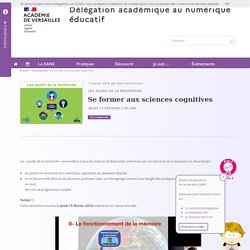
Présentation du contenu abordé et des échanges possibles : Avec la nomination le 10 janvier 2018 de l’éminent Stanislas Dehaene à la tête du conseil scientifique de l’éducation nationale, dont 11 membres sur 22 sont spécialistes des sciences cognitives, il peut être intéressant de mieux comprendre le périmètre et les enjeux de cette approche scientifique des apprentissages. The science of learning. Retrieval Practice concept map. "How to Study Less and Learn More": Explaining Learning Strategies to our Students. Because cognitive science gives us such good guidance about learning, we want to share that information with our students.
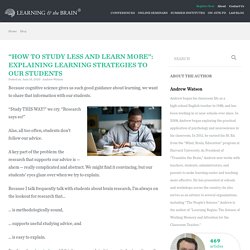
“Study THIS WAY!” We cry. “Research says so!” Alas, all too often, students don’t follow our advice. A key part of the problem: the research that supports our advice is — ahem — really complicated and abstract. Because I talk frequently talk with students about brain research, I’m always on the lookout for research that… … is methodologically sound, … supports useful studying advice, and … is easy to explain. I’ve found such a study, and I think we can explain it to our students quite easily. MakeItStickFR (DRHAT) SpacedLearningExemple(DRHAT) CarteMentaleMémorisation(DRHAT) MultiTesting(DRHAT) Consolidation mnésique (DRHAT) Apprendre et réussir (1): comprendre sa mémoire. Apprendre et réussir (2): conseils pratiques pour mieux étudier. Apprendre et réussir (3) : quand et où pratiquer sa mémoire.
Fiche mémo prof(DRHAT) What every teacher should know about ... memory. There is a wealth of psychology research that can help teachers to improve how they work with students – but academic studies of this kind aren’t always easy to access, or to translate into the realities of classroom practice.
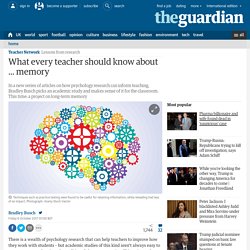
This series seeks to redress that, by taking a selection of studies and making sense of the important information for teachers. No one study or journal can provide a definitive answer, but they can help offer some guidance. Some of the studies I will choose in these articles are iconic, some quirky, some are large scale, and some have a small sample size. But all of them look to help answer the question: how can we help our students do better at school?
We begin with a study on memory. Long-term learning How do our students learn? This study is one of the most thorough and comprehensive appraisals on strategies that students employ to improve their memory. What are the main findings? Two techniques were rated as being very effective for improving long-term memory: Learning poster 1. BRI Cognitive Science poster. The problem with ‘reading along’ It has become an unwritten law of teaching that when reading aloud to students, the teacher must ensure students are reading along in their own copy of the text.
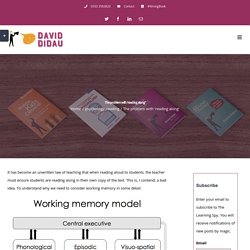
This is, I contend, a bad idea. To understand why we need to consider working memory in some detail. It’s well-known that the capacity of working memory is strictly limited – estimates range from anywhere between 4 to 9 items at any one time – but it’s less well-known that working memory is almost certainly not a single edifice. Baddeley and Hitch‘s widely accepted working memory model contains four distinct components. The central executive* (CE) focuses our attention on the information we want to process. A model for the learning process. And why it helps to have one. One of the most powerful ideas I’ve engaged with recently is using a diagram to visualise a shared model of the learning process; using it to get a feel for how learning works in general but also to identify reasons for why it can sometimes not happen.

This is the diagram I have in my Rosenshine Principles book, courtesy of Oliver Caviglioli: I’ve found it massively helpful as a focus during CPD as we’ve explored a range of interlocking, overlapping ideas: Willingham’s ‘memory is the residue of thought’ and various ideas in the classic ‘Why do students forget everything I say?’ The near inevitability of forgetting, the role of retrieval, the need to connect new learning to prior knowledge and a whole host of other issues can be explored in some depth where we have a shared focus for framing the discussion: Le manque de sommeil altère le cerveau des ados. Sleep habits, academic performance, and the adolescent brain structure Anna S.
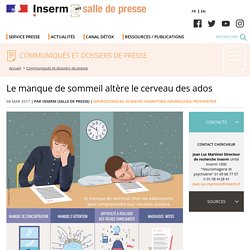
Urrila1,2,3, Eric Artiges1,4, Jessica Massicotte1, Ruben Miranda1, Hélène Vulser1, Pauline Bézivin-Frere1, Winok Lapidaire1, Hervé Lemaître1, Jani Penttilä1, 5, Patricia J Conrod6, 7, Hugh Garavan8, the IMAGEN consortium, Marie-Laure Paillère Martinot1, 9, and Jean-Luc Martinot1, 10* 1 Institut National de la Santé et de la Recherche Médicale, INSERM Unit 1000 “Neuroimaging & Psychiatry”, University Paris Sud – Paris Saclay, University Paris Descartes - Sorbonne Paris Cité, 97 Bd de Port Royal, 75014, Paris, France. 2 National Institute for Health and Welfare, Department of Health, Unit of Mental Health, P.O.
Internet use in class tied to lower test scores. Warning: Surfing the internet in class is now linked to poorer test scores, even among the most intelligent and motivated of students.

Michigan State University researchers studied laptop use in an introductory psychology course and found the average time spent browsing the web for non-class-related purposes was 37 minutes. Students spent the most time on social media, reading email, shopping for items such as clothes and watching videos. And their academic performance suffered. Cécité d'inattention. Hirsch : Can you always look it up ? Cone of learning or cone of shame? I'm sure you've seen a figure like this.
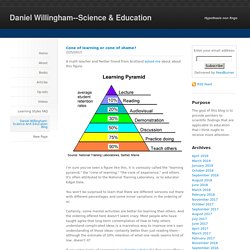
It is variously called the "learning pyramid," the "cone of learning," "the cone of experience," and others. It's often attributed to the National Training Laboratory, or to educator Edgar Dale. You won't be surprised to learn that there are different versions out there with different percentages and some minor variations in the ordering of acCertainly, some mental activities are better for learning than others. And the ordering offered here doesn't seem crazy. Most people who have taught agree that long-term contemplation of how to help others understand complicated ideas is a marvelous way to improve one's own understanding of those ideas--certainly better than just reading them--although the estimate of 10% retention of what one reads seems kind of low, doesn't it?
This is just an off-the-top-of-my-head list of factors that affect memory retrieval. Cognitive biases. Articles de D. Willingham (psychologie cognitive) Sur les intelligences multiples de Gardner. Frames of Mind: The Theory of Multiple Intelligences (Basic Books, 1983) Multiple Intelligences: The Theory into Practice (Basic Books, 1993) Intelligence Reframed: Multiple Intelligences for the 21st Century (Basic Books, 1999) By Howard Gardner Checked by Daniel T.

Willingham What would you think if your child came home from school and reported that the language-arts lesson of the day included using twigs and leaves to spell words? Armstrong is far from alone in placing faith in Gardner’s theory of “multiple intelligences.” Central Claims Gardner first proposed his theory in 1983.
Do Visual, Auditory, and Kinesthetic Learners Need Visual, Auditory, and Kinesthetic Instruction? How Has Modality Theory Been Tested? The Content's Best Modality Is Key.